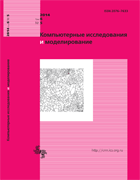All issues
- 2024 Vol. 16
- Issue 1 (special issue)
- 2023 Vol. 15
- 2022 Vol. 14
- 2021 Vol. 13
- 2020 Vol. 12
- 2019 Vol. 11
- 2018 Vol. 10
- 2017 Vol. 9
- 2016 Vol. 8
- 2015 Vol. 7
- 2014 Vol. 6
- 2013 Vol. 5
- 2012 Vol. 4
- 2011 Vol. 3
- 2010 Vol. 2
- 2009 Vol. 1
Molecular model of OCP-phycobilisome complex formation
A molecular model of phicobilisome complex with a quenching protein OCP which regulates the energy transfer from phicobilisome to photosystem in photosynthetic apparatus of cyanobacteria has been developed. In the model obtained a well known spatial structure of interacting proteins remains intact and also the energy transfer from phycobilisome to OCP with reasonable rates is possible. Free energy of complex formation was calculated using MM–PBSA approach. By the order of magnitude this energy is about tens of kJ/mole. This value correlates well with experimental observed low stability of this complex. The specific surface energy of interaction between hydrophylic phicobilisome and OCP is twice larger than specific surface energy of their interaction with water. This reflects a high molecular complementary of interacting protein surfaces and is a strong pro argument for proposed model.
Indexed in Scopus
Full-text version of the journal is also available on the web site of the scientific electronic library eLIBRARY.RU
The journal is included in the Russian Science Citation Index
The journal is included in the RSCI
International Interdisciplinary Conference "Mathematics. Computing. Education"







